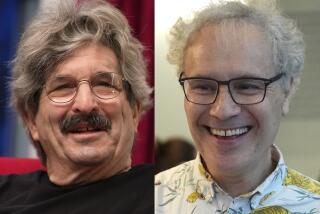Simon van der Meer dies at 85; physicist shared Nobel Prize for discovery of elementary particles known as W and Z
- Share via
Dutch physicist Simon van der Meer, who shared the 1984 Nobel Prize in Physics with Italian physicist Carlo Rubbia for the discovery of the elementary particles known as W and Z that link two of the four fundamental forces of nature, died of undisclosed causes March 4 in Geneva. He was 85.
The “standard model” of physics says that there are four fundamental forces in nature: gravity, electromagnetism, the strong force (which holds atoms and elementary particles like protons and neutrons together) and the weak force, which is involved in radioactive decay.
Theory predicted that the weak force was mediated by two very heavy particles called W and Z, which link it to electromagnetism, but until van der Meer and Rubbia’s work, no one had ever seen either of the particles.
Rubbia reasoned that the Super Proton Synchrotron (SPS), the particle accelerator at the European Organization for Nuclear Research (CERN) in Switzerland, could be harnessed to produce the particles by smashing together beams of protons and their exotic antimatter counterparts, antiprotons.
In order to produce a mere 10 W and Z particles, physicists calculated that a billion proton-antiproton collisions would be necessary. To achieve that on a reasonable time scale would require several hundred billion antiprotons circulating in the accelerator ring.
Antiprotons were produced in a smaller accelerator, but collecting them and focusing them into a beam that could be injected into the SPS was an extremely difficult task (imagine herding cats, multiplied 100 times).
Van der Meer’s unique contribution to the project was designing a system that allowed the collection to occur so that the desired collisions could take place. His technique, called stochastic cooling, “was typical of a Simon van der Meer invention: deceptively simple at first sight, but to anyone who truly understands accelerators it was nothing less than a stroke of genius,” Rolf-Dieter Heuer, director-general of CERN, and Stephen Myers, director of accelerators and technology, said in a statement.
In 1983, the laboratory reported the discovery of the W and Z particles, which began shifting the center of physics research from the United States to Europe.
The importance of the discovery was certified when the Nobel committee awarded the prize to Rubbia and van der Meer only a year later, a very short period as Nobel recognition goes.
CERN’s main U.S. competitor, Fermilab, subsequently added stochastic cooling to its Tevatron and used the newly configured accelerator to discover the top quark, the final piece of the standard model puzzle, in 1994.
Simon van der Meer was born Nov. 24, 1925, in The Hague, the Netherlands, the son of a schoolteacher. He finished high school at the Gymnasium in The Hague in 1943. Because Dutch universities were closed during World War II, he spent two more years studying humanities at the school and experimenting on his own in electronics.
Among other projects, he built a radio that allowed his family to listen to war news.
After the war, he studied physics at Delft University of Technology, then joined the physics laboratory at the Dutch electronics company Philips in Eindhoven, where he worked on electron microscopes. In 1956, he joined the recently formed CERN, where he spent the rest of his career until his retirement in 1990.
Van der Meer “was an incredibly inventive man,” Heuer and Myers said. “When confronted with a problem, he would sink into deep reflection, rarely emerging until he had a solution.”
Van der Meer is survived by his wife of 44 years, the former Catherina Koopman; a son, Mathijs; a daughter, Esther van der Meer; a sister, Gay van der Meer; and a granddaughter.
More to Read
Start your day right
Sign up for Essential California for the L.A. Times biggest news, features and recommendations in your inbox six days a week.
You may occasionally receive promotional content from the Los Angeles Times.





